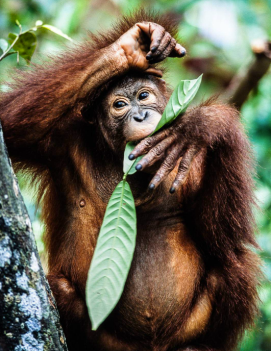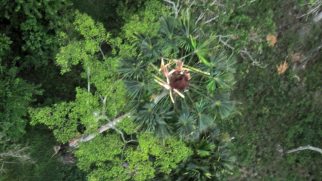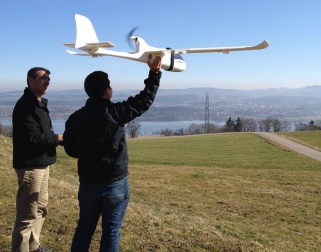
The Bornean orangutan is endangered while the Sumatran orangutan is critically endangered. Both species are found only in the tropical forests of Indonesia and Malaysia. Photo credit: Perry van Duijnhoven.
WITH A SHAGGY coat of red hair and a comically round face, the orangutan looks more like a Muppet than a great ape. While their appearance is outwardly foreign, orangutans are among our closest relatives in the animal kingdom; they are highly intelligent, and share 97% of our DNA.
Both species of orangutan are found only in the tropical forests of Indonesia and Malaysia. Unfortunately, rampant habitat destruction, fueled by a surging demand for palm oil, has destroyed 90% of orangutan habitat in the past 20 years.
So it may come as a surprise that a recent population survey of orangutans on Sumatra found over twice as many apes as expected.
Researchers now estimate that as many as 14,600 orangutans live on the island of Sumatra, compared to the estimate of 6,600 apes back in 2008.
Scientists caution against misinterpreting the new results as evidence of an orangutan recovery. According to the study, the new population estimate reflects a change in research methods, not actual orangutan abundance.

A drone’s view of an orangutan in it’s nest in the forest canopy. The geographic range of the Sumatran orangutan is now thought to be 17,800 sq km, about 2.5 times the previous estimate. Photo credit: Conservation Drones.
Researchers surveyed habitats previously thought to be unsuitable for orangutans, such as montane forests and secondary forests recovering from logging. Much to their surprise, the less suitable forest habitats did indeed have orangutans.
Researchers also detected more orangutans then before by recording the presence of orangutan nests in the forest canopy using drone technology.
While it’s important to note that orangutan populations haven’t actually increased and that habitat destruction still threatens their very survival, the findings are an important step forward for orangutan conservation. The new data will be used to more accurately pinpoint orangutan critical habitat and allow policy makers and conservationists to design more representative protected areas.
Given the importance of accurate population data for species conservation, drone technology is being viewed by many in the scientific community as a valuable tool for population monitoring.
Counting Orangutans with Drones
For researchers on Sumatra, drones presented an exciting opportunity to improve the accuracy of orangutan population monitoring.

UAVs can be small; some look more like model airplanes than conventional drones. Armed with a GPS, autopilot, and HD camera, drones can be programmed to fly transects over a study area. Photo: Conservation Drones.
Conservation drones, also known as unmanned aerial vehicles (UAVs), are not designed to carry a military payload or deliver Amazon Prime packages. Instead, they serve as ecological monitoring tools and are equipped with GPS units, autopilot software, and high definition cameras.
Using free open-source software, researchers programed the drones to fly set transects over the forest to snap pictures of orangutan nests.
Aside from take off, the drones are completely autonomous: they automatically fly between the waypoints set by researchers, playing out a giant game of connect the dots over the forest canopy.

A photo, taken by a drone, shows the difference between palm oil plantations (left) and natural rainforest (right). Drone footage can be used to generate maps of habitat condition or track deforestation. Photo credit: Conservation Drones.
UAVs allow researchers to drastically scale up the scope of their population surveys. Traversing the dense tropical jungle on foot is time consuming and cumbersome; walking a 5 km transect in search of orangutans can take an entire day. Conservation drones, on the other hand, are capable of flying 50 km in as little as 40 minutes.
In addition to counting nests, the high definition aerial imagery can be used to generate three-dimensional maps of the forest canopy to assess habitat quality or to track the expansion of palm oil plantations.
Two of the team’s researchers, Serge Wich and Lian Pin Koh, have also founded the company Conservation Drones to reduce the cost of research UAVs. At under $2000 a pop, their UAVs look more like model airplanes than conventional drones, and cost less than other research equipment such as laptop computers.
You can watch Koh speak about the conservation potential of drones in this TED Talk.
Other Applications of Conservation Drones
Conservationists often use drones to count animal populations that are either very large or remote, making them hard to study by conventional means. Aside from orangutans, researchers have used drones to monitor caribou, nesting sea birds, and even migrating salmon.
But the conservation applications of drones extend beyond population surveys or habitat mapping.
As programmed, automated machines, drones can carry out repetitive or large-scale conservation tasks far more efficiently than researchers. Drones have been deployed to disperse hoards of invasive starlings, control outbreaks of coral eating starfish, and to patrol the borders of protected area and national parks to detect and deter trespassers.
Complete with live stream video feeds and thermal imaging cameras, drones have been used in South Africa in the fight against poaching and wildlife crime. One project called the Air Shepard Initiative uses drones to detect animal and poacher locations inside national parks. This drone data can be plugged into an algorithm to predict the location of future poaching hot spots inside the national park, allowing rangers to focus their efforts in the fight to protect rhinos, elephants, and other wildlife.

Drones can be used for underwater research too. The Woods Hole Oceanographic Institute launched the REMUS project in 2013 to study the behavior of great white sharks in the wild using drones. Photo credit: Discovery.
Drones can also be used to collect data in situations that might be dangerous for human researchers, such as studying the attack behavior of great white sharks.
In the future, scientists hope to use drones to collect data from other monitoring devices. In theory, drones could be used to download data from Wi-Fi enabled camera traps or radio-tracking collars as they fly overhead, sparing researchers extra trips into the field to retrieve data themselves.
Even with all these applications, drones have their limitations. Many are expensive, have limited battery life, and perform poorly in adverse environmental conditions. There are legal hurdles to using drones as well, as regulations lag behind the technology.
In spite of these caveats, UAVs are a powerful emerging conservation tool. By opening up new outlets for research and analysis, drones will ultimately lead to more exhaustive data and monitoring efforts, and thus more effective conservation.
What YOU can do
Participating in drone conservation research isn’t easy – many scientists and most laypeople don’t have access to drones due to high costs or legal hurdles. If you do own a drone, some citizen science projects will allow you to participate directly in drone research, such as this one focused on documenting the effects of El Niño.
When it comes to the orangutan, you don’t need a drone to help out. Your choices as a consumer impact the demand for palm oil, the driving force behind the orangutan’s decline.
Here are 3 easy ways to reduce your palm oil consumption:
- Eat Less Processed Food – Snacks and processed foods have some of the highest percentages of palm oil by volume. A great first step to palm oil reduction, and a healthier lifestyle in general, is reducing your intake of processed foods. By cooking for yourself, you can control exactly what goes into your food!
- Read Ingredient Lists – Palm oil is found in roughly 50% of consumer goods, and may be masquerading under as many as 30 different names on a product’s ingredient list. Click here for a pocket guide listing some of palm oil’s most common aliases, or download one of these barcode-scanning apps to identify products containing palm oil.
- Pay Attention to Brands – Palm oil can be harvested sustainably. While many major snack food companies have pledged to source only RSPO certified sustainable palm oil, some have followed through better than others. Check out this scorecard rating popular snack food brands based on their commitment to sustainability, and then shop accordingly.

From left to right: The Palm Oil Initiative Barcode Scanner app, Cheyenne Zoo’s Palm Oil Shopping Guide app, the barcode scanner app Buycott, and the logo for RSPO, indicating sustainable production of palm oil.
By reducing your palm oil consumption, you help to ensure that conservation drones flying over Indonesia will see many more orangutan nests for years to come.
LEARN MORE
- What is the relationship between Indonesian Wildfires, El Niño, and Palm Oil?
- Greenpeace lauds Nestle and Ferrero palm oil pledges, slams others
- TED Talk – A Drone’s Eye View of Conservation
- Scientists use Underwater Drones to Protect the Great Barrier Reef


Good to hear of a great use for drones – now to deploy them to save the chimps, rhinos, gorillas, elephants and the rest.
LikeLiked by 1 person
Yes, drones certainly have immense potential to aid in many conservation causes
LikeLike
in my country (Indonesia) orangutans have been protected by legislation since 1931, because of the orangutans including protected animals
LikeLike
And with better population survey data that drones provide, those protected areas can hopefully be broadened to protect more orangutans
LikeLike
This is great news! A census “increase” of 8,000 individuals (even if it’s just a more accurate count) is definitely a good thing. Hopefully this eventually sheds more light on how well Orangutans can thrive in those other habitats (logged forest, montane forest) too.
LikeLiked by 1 person
[…] Read more here:https://howtoconserve.org/2016/03/11/drones-orangutan-conservation/ […]
LikeLike
Reblogged this on Opher's World and commented:
It is so important that we preserve these brothers of ours. We are trashing the planet. These are desperate times. Maybe drones are the way forward for conservation?
LikeLiked by 1 person
[…] Source: Using Drones to Improve Orangutan Conservation […]
LikeLike
[…] Populations of the vaquita porpoise, eastern gorilla, plains zebra, elephants, rhinos, and orangutans all showed worrying signs of decline in […]
LikeLike